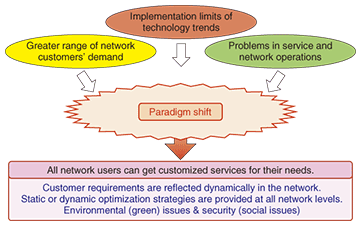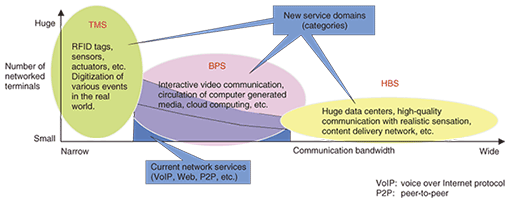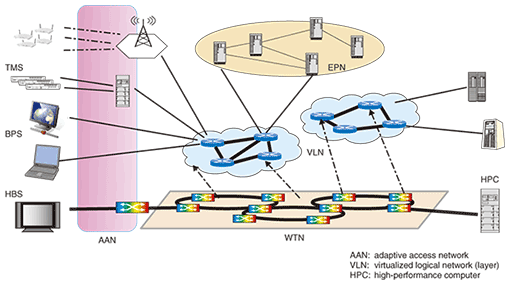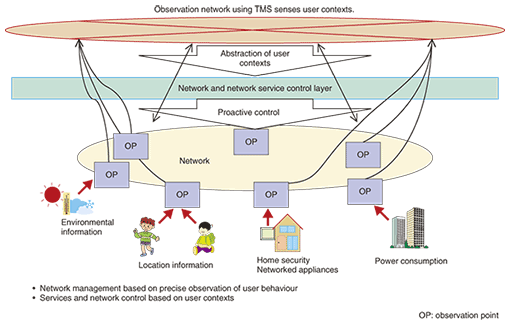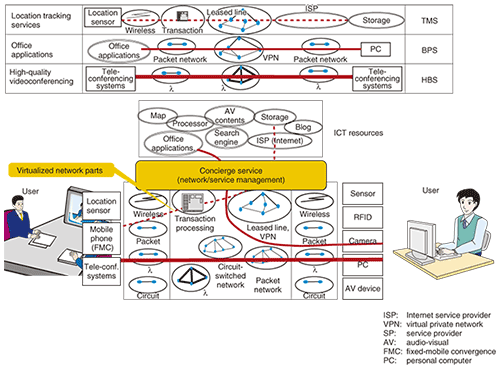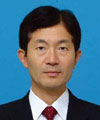 |
|||||||||||||||||||||||||||
|
|
|||||||||||||||||||||||||||
|
Special Feature: Design Concepts for New Generation Carrier Networks Vol. 7, No. 5, pp. 19–26, May 2009. https://doi.org/10.53829/ntr200905sf1 R&D Challenges for Future Carrier NetworksAbstractIn this article, we present our ideas for new-generation networks and clarify the main problems associated with the current networks. We also describe our research and development targets and approach to the future network infrastructure for carriers. We think that the network should be capable of providing three kinds of services to meet customer requirements: huge-bandwidth services, broadband packet services, and tiny-bandwidth mass services. An effective way to achieve flexible deployment of service applications will be to integrate resource virtualization into network service management. Another key technique will be low-power-consumption designs for network equipment.
1. Toward network innovationsThe continuous development and acceptance of useful and attractive applications has led to the Internet becoming a fundamental social infrastructure. The visionary statement [1] of the National Institute of Information and Communications Technology (NICT) suggests that information and communications technology (ICT) has great potential for helping to solve significant social problems, such as the excessive energy consumption of human beings and threats to safety in people’s daily lives. Towards this end, many organizations have started research and development efforts to design future networks, including the National Science Foundation in the USA [2], FP7 (Seventh Framework Programme) in the EU [3], and NICT in Japan. NTT’s R&D challenge is to solve the problems that are caused directly by current networks themselves. Our solutions should yield new-generation network technologies from our perspective as a carrier. In efforts to address these problems, customer-oriented freely defined logical networking, with cooperation between customers and responsible network service providers, must play a key role. We think that the service operation technique, which utilizes customers’ context information, will be effective for achieving these objectives. This article introduces a paradigm shift in design for new-generation networks that can solve these problems. 2. Key issues for future networks2.1 Greater range of network customers’ demandsThe first challenge of a network is to achieve service flexibility so that it can adaptively provide a wide range of network services to each customer. Future networks will need to satisfy a greatly expanded range of customer demands. Various service parameters will need to be scaled up to accommodate the wide variety of network applications demanded by each customer with different levels of network quality of service (QoS), which covers factors such as bandwidth, transmission delay, and jitter. In addition, the number of terminals involved should be considered. The traffic characteristics of different customers will be extremely diverse because of the huge variety of applications. Since the mid-1990s, the Internet has been expanding rapidly, with email and the World Wide Web becoming the main applications. Other attractive applications such as e-commerce including online auctions, social networking services, digital contents downloads, and online games, have been developed and are being widely deployed across the globe. IPTV (Internet protocol television) is undergoing international standardization at ITU-T (International Telecommunication Union, Telecommunication Standardization Sector) [4], and TV programs are expected to be widely and generally viewed via the Internet soon. Although some Internet distribution services have already begun, they cannot provide high quality because they lack QoS management. ITU-T standardization takes into consideration managed networks and environments for standard- and high-definition television program quality to be established world-wide [5]. In the business field, a wide variety of network-based applications and services have been adopted. Since the leakage of confidential information is a critical issue for companies, thin-client style computation is widely recognized as a secure approach for businesses. SaaS (software as a service) and PaaS (platform as a service) applications are recognized as cost-effective solutions. Data storage networking has also been widely adopted by many companies as a cost-effective solution. The use of videoconferencing is also increasing in business. We believe that applications based on one or more network services will only increase in the future. In recent years, low-cost wireless networking techniques have been widely and rapidly adopted. Passive radio-frequency identification (RFID) is expected to lead to efficient management of manufactured goods. Even the management of paper documents is possible with the use of very small integrated circuit chips. Active RFID systems, such as described in [6], are another category of low-cost wireless networking. For a long time, it has been difficult to advance networking to many kinds of small devices because the networking cost was rather high. However, the cost can be reduced through the use of active RFID technologies, which enable a great many network application ideas to be put into actual use. One example is environmental protection provided by sensor network systems in both urban and rural areas. It might also be possible to provide remote control of appliances, road traffic controls, and the marketing and logistics of commercial products at low cost. To support stress-free usage for customers, future networks will need to satisfy the following conditions. Bandwidth of more than 10 Gbit/s must be provided for customers who want high-quality interactive videoconferencing with uncompressed high-definition video streams and stress-free gigabyte-class digital file transfer between server and client. Delay-sensitive applications, such as interactive videoconferences and high-speed transaction processing tasks, require an extremely short transmission delay, comparable to the time required for the propagation of light. On the other hand, very-low-cost wireless connections are needed to link extremely low-cost devices to a network. Typical examples of such devices are sensor devices and RFID tag-like devices. These types of network services need to handle a tremendous number of terminals and their IDs because the number of terminals required may become much greater than the number of human beings inhabiting the earth. When a major proportion of our daily activities depends on one network or another, the networks should be able to provide connectivity anywhere and anytime; otherwise, our activities will certainly be disrupted when the connection is lost. To provide network connections everywhere, it is essential to develop techniques that will provide network services seamlessly from within buildings to areas outside them. 2.2 Performance limits of technology trendsThe second challenge is to create a new paradigm to overcome current network capacity limitations. According to statistics from the Ministry of Internal Affairs and Communications in Japan [7], total network traffic of broadband users is continuing to expand by 20–50% per year nationwide. If this traffic increase continues, the traffic in 2020 will be a hundred times the current amount. Providing sufficient capacity for the decades after 2020 will require network capacity increases of a thousandfold over the current level. The plan is to construct photonic transport networks with per-fiber capacity of well over 10 Tbit/s: this will require the development of innovative transmission technologies that can provide higher sensitivity to reduce the amount of power that must be launched into the fiber [8]. One opinion that has been expressed in various quarters is that the energy consumption of networks, including the Internet, is too high and that this is a major cause for concern because this energy consumption will grow as the networks expand. Thus, when we design network systems for the future, we must consider not only their performance (e.g., ultrawide bandwidth and low latency) but also their energy consumption. These days, it is socially unacceptable to consume energy at a level in proportion to that of the network capacity. 2.3 Problems in service and network operationsThe third challenge is related to service and network operations. We assume that the diversity of customers’ service requirements will continue to increase. The resulting diversity in services and the increase in the number of service categories will make management procedures more complex and multiply the number of service operations functions needed. This will certainly create hardships for the network operators. Customers will certainly need plug-and-play functions to enable them to more easily use the various devices available to them to access network services. Consequently, it will undoubtedly become very difficult for all customers to make full use of the services provided to them. We are, therefore, convinced that an automatic setup function is indispensable for the new-generation networks. We believe that user support functions that can optimize the services needed to meet customers’ demands will be essential to achieve customer satisfaction. Operations systems will need to support customers by satisfying each of their unique and distinct requirements. One of the indispensable functions of network operations is to provide stable network performance under all conditions, even when failures occur. To make this function a reality, the network operation system should bring all relevant equipment and traffic under its control. The operation system must be able to provide conscientious support for each customer by monitoring the network status as well as customer behavior pertaining to network usage. Thus, we believe that the new-generation networks must offer a new network operations scheme based on sensing customer behavior to further improve customer satisfaction. 3. Paradigm shift for new-generation networksOur understanding of the paradigm shift needed to create the future network infrastructure is shown in Fig. 1. Our research efforts are addressing these aspects to clarify the network architecture needed by around 2020.
3.1 Expanding diversity of network servicesTo respond to the wide variety of customer requirements, the network should be capable of providing a wide range of network services. We have classified future network services into three categories based on the axes of bandwidth and number of terminals, as shown in Fig. 2. These are: – Huge-bandwidth service (HBS) – Broadband packet service (BPS) – Tiny-bandwidth mass service (TMS).
HBS will be a high-quality network service that provides a huge bandwidth of more than 10 Gbit/s and low transmission latency between end points, which may be terminals, servers of some sort, or network nodes within a network. This service will support customers who need very-large-capacity communication channels or extremely low-latency connections between terminal equipment. HBS will be implemented as a high-performance channel between end points. It will use circuit-based switching rather than packet-based switching. This service must provide stable and secure communication quality between end points. BPS will be a packet-based network service like the Internet. However, it is regarded as an advanced network service that overcomes the weaknesses of the current Internet. It will solve current Internet problems with, for example, QoS, security, mobility, and router throughput limitations. TMS will accommodate an enormous number of terminals each with very limited functions, such as sensor nodes and RFID tags. It will handle event data from them effectively at low cost. In the future, ICT will be applied not only to contexts on the Internet, but also to various events in the real world using sensor networks. Therefore, TMS will play an important role in achieving the ubiquitous and mobile applications needed to assist people. 3.2 Service characteristicsThe basic architecture model of these three services is shown in Fig. 3. HBS will be provided mainly by the functions of a wide-area transparent network (WTN). In particular, for high-end communication systems, end-to-end optical paths will be assigned on demand. BPS will be formed as an overlay network on the WTN. It will be implemented by network virtualization [9] in order to provide flexible performance. While HBS and BPS are network services, TMS is a type of service platform on which various kinds of events and data from sensor or RFID devices will be processed. TMS will consist of dedicated servers and packet networks connected to them by BPS. These servers will perform event data processes such as capturing, filtering, and event data logging. Therefore, we call this platform an event processing network (EPN).
3.3 Expanding network capabilities and green limit for ecological networkingSince IP traffic is projected to continue maintaining its growth rate of doubling each year or so, carriers will need to transport 100 Tbit/s or more per fiber, i.e., one hundred times the traffic of current state-of-the-art transport systems, by 2020. One promising way to boost the performance of optical transport networks is to optimally combine optics with state-of-the-art modulation/demodulation technologies derived from wireless developments, such as phase modulation, multilevel modulation, and coherent detection with digital signal processing technologies [10]. Wireless communication technologies are indispensable for future ubiquitous networking. In this field, faster and more stable data transmission is desired. We are developing ultrahigh-speed wireless access network systems [11], [12]. Reducing energy consumption and/or CO2 emissions may impose severe restrictions on network implementation with regard to its capacity (the green limit). This is the most immediate and pressing problem for us. From the viewpoint of ecological networking, the most effective area to address is the access networks because there will be tens of millions of nodes such as optical line terminals and optical network units that will constantly be on. Our research target is to build an adaptive access network (AAN) that is energy-scalable according to the bandwidth that users actually need. In addition, the AAN will be able to accommodate access lines at virtually any point in the core network. This feature will also achieve effective utilization of the entire network. 3.4 Network and network service operations in the futureAs mentioned above, to effectively reduce network power consumption, we should know the network status at every point in the core, access, and user networks. Today’s networks are conventionally observed at the level of the router and switching nodes. However, this observation focuses mainly on things relevant to the lower network layers, such as packet flow and link status. Therefore, the status of network services, which is the main concern of network users, should be observed in each service system individually. This will increase the complexity of network service operations systems and make it difficult to define exactly what the services must provide unless we know each customer’s requirements precisely. Future networks and network service operations systems will need to consider customers’ needs and contexts. With this idea in mind, we present here a novel architecture for a network/service operations system based on user contexts. The system’s basic architecture model is shown in Fig. 4. In this system, communication status is closely observed and estimated at the end-points and recognized as the context. Intelligent control and support is provided according to the context of user behavior in the network. Proactive control is done based on this contextual information. This architecture will make maximum use of network resources and provide various types of services without putting any stress on the user.
In addition, networks should flexibly and quickly provide required network services to support customers. For this purpose, virtualization of service elements will play a key role. Network services can be provided to customers by utilizing many ICT resources. A typical example is as follows: when a customer uses a multisite videoconferencing service with his colleagues, the service may consist of communication channels, videoconferencing terminals in all the locations, and a centralized video conference server that manages speakers’ images and voices so as to suitably deliver them to all other sites during the conference. If the network provides the necessary resources in a virtualized manner, the operator can set up all the necessary resources in the same way. No physical actions, such as setting copper cables, installing optic fiber lines, or inputting settings to servers, are needed. We believe that virtualization will play a significant role in the new-generation networks. An operation model of this concept is shown in Fig. 5. Innovative networking technologies and various application technologies must be tightly coupled. A new network service operations system that takes account of user context and behavior will provide appropriate customized services to each network user.
4. ConclusionIn this article, we proposed a design concept for new-generation networks from the viewpoint of network carriers. Integrating resource virtualization into network service management will enable flexible deployment of service applications. We believe that these ideas and research efforts will provide effective solutions to current Internet problems and help to achieve new-generation networks within a few decades. Basic research and field trials will be required to consolidate and fully implement the ideas presented here. These will be subjects for our future work as well as open targets for all network designers. References
|
|||||||||||||||||||||||||||








